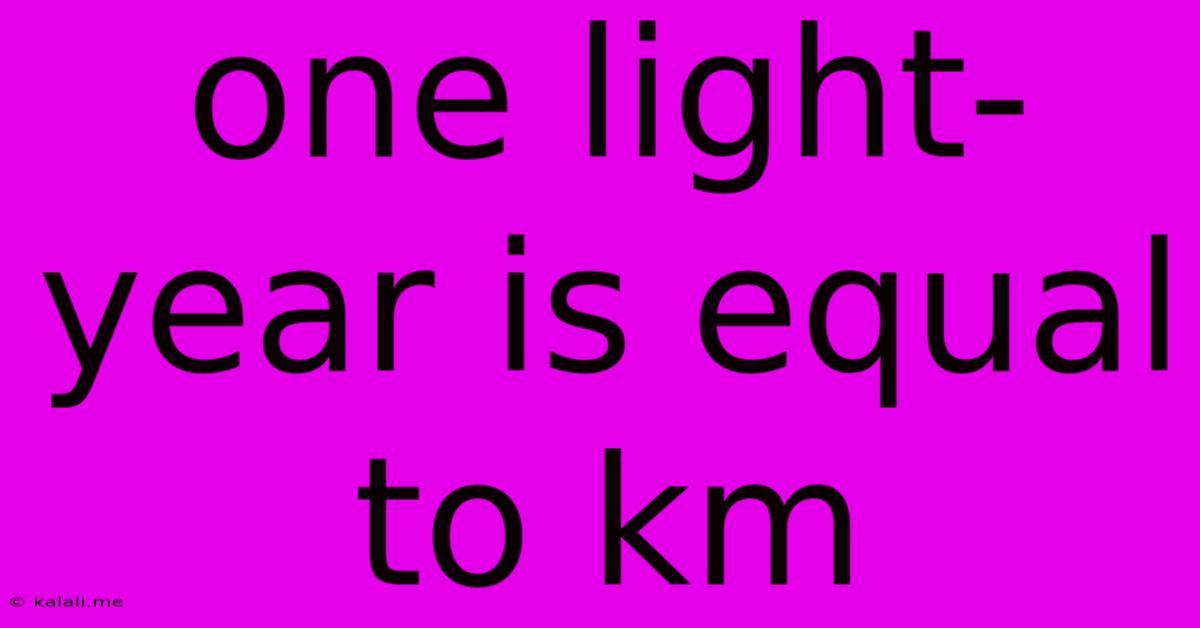One Light-year Is Equal To Km
Kalali
Jun 11, 2025 · 3 min read

Table of Contents
One Light-Year: How Far is it Really in Kilometers?
Ever wondered just how far a light-year actually is? This seemingly simple question opens the door to understanding the vastness of space and the incredible speeds of light. This article will delve into the precise conversion of a light-year from its familiar astronomical unit to kilometers, a unit more relatable to our everyday experience. We'll explore the calculations involved and discuss the significance of this measurement in the context of astronomy.
A light-year isn't a measure of time, as its name might suggest. Instead, it's a measure of distance. It represents the distance light travels in a single Earth year. This distance is enormous, highlighting the sheer scale of the cosmos. So, let's break down the conversion from light-years to kilometers.
Understanding the Calculation
To convert a light-year to kilometers, we need two key pieces of information:
- The speed of light: Light travels at approximately 299,792,458 meters per second (m/s) in a vacuum. This is a fundamental constant in physics.
- The number of seconds in a year: There are approximately 31,536,000 seconds in a year (365.25 days x 24 hours/day x 60 minutes/hour x 60 seconds/minute). We use 365.25 days to account for leap years.
Now, let's perform the calculation:
- Meters in a light-year: Speed of light (m/s) x seconds in a year = approximately 9,461,000,000,000,000 meters.
- Kilometers in a light-year: Meters in a light-year / 1000 meters/kilometer = approximately 9,461,000,000,000 kilometers (9.461 trillion kilometers).
The Immensity of a Light-Year
The result – approximately 9.461 trillion kilometers – truly emphasizes the vast distances involved in astronomy. To put this into perspective, the distance from the Earth to the Sun (one astronomical unit) is roughly 150 million kilometers. A light-year is over 63,000 times greater than that distance! This explains why even the closest stars to our Sun, measured in light-years, are incredibly far away.
Light-Years in Astronomy
Light-years are crucial in astronomical measurements for several reasons:
- Measuring interstellar distances: They provide a practical and easily understood scale for describing the distances between stars and galaxies, which are far too vast to express in kilometers.
- Understanding cosmological events: Light-years help us understand the timing of celestial events. When we observe a supernova in a galaxy millions of light-years away, we're seeing an event that happened millions of years ago. This allows us to study the history of the universe.
- Mapping the universe: The use of light-years is essential in constructing three-dimensional maps of our galaxy and the universe beyond.
In conclusion, while a light-year might seem like an abstract unit, understanding its conversion to kilometers provides a tangible grasp of the immense scales involved in the study of the universe. It's a fundamental unit that helps us navigate and comprehend the vastness of space and the incredible journey of light across the cosmos.
Latest Posts
Latest Posts
-
Laplace Transform Calculator With Initial Conditions
Jun 12, 2025
-
How Many Watts Is 1 Hp
Jun 12, 2025
-
Which Of The Following Is Not A Domain
Jun 12, 2025
-
How Many Days Is 225 Hours
Jun 12, 2025
-
In Which Of These Can Convection Not Occur
Jun 12, 2025
Related Post
Thank you for visiting our website which covers about One Light-year Is Equal To Km . We hope the information provided has been useful to you. Feel free to contact us if you have any questions or need further assistance. See you next time and don't miss to bookmark.